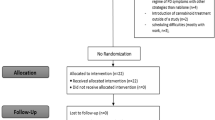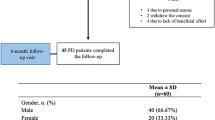Abstract
Homotaurine is a natural compound of red algae, which has been demonstrated to have a neuroprotective effect and has been evaluated as a possible therapeutic agent for Alzheimer’s disease. This was a single blind, randomized, controlled study to evaluate the safety and efficacy of homotaurine in patients with Parkinson’s disease (PD) and cognitive impairment. Patients were evaluated at baseline and 6 months later. Assessments included, the evaluation of: motor and non-motor conditions and complications (Unified Parkinson’s Disease Rating Scale, UPDRS); disability and quality of life; depression; excessive daytime sleepiness and fatigue. An extensive neuropsychological tests battery was administered evaluating specific cognitive domains: memory, phonemic verbal fluency, executive functions and selective visual attention. After baseline testing, patients were allocated to one of the two groups: (A) treatment group: patients treated with homotaurine 100 mg; (B) control group: patients not treated with homotaurine. Forty-seven patients were evaluated at baseline, 24 (51 %) completed the study (PD-homotaurine: n = 11; 44 % and PD-controls: n = 13; 59 %); discontinuation rate was similar across subjects (p = 1.0). Intention to treat analyses to evaluate homotaurine safety showed mild side effects (gastrointestinal upsetting) in 3 patients. Per protocol analyses of homotaurine efficacy showed no difference between groups. Within group analyses showed that PD-homotaurine patients had better score at UPDRS-I at the end of the study compared to baseline (p = 0.017) and at Epworth Sleepiness Scale (p = 0.01). No other differences were found. No significant difference arose for the PD-ctrl group. Homotaurine is a safe drug. Our data suggest a beneficial effect of homotaurine on excessive sleepiness. Future studies are encouraged to confirm this promising role of homotaurine in promoting the sleep/awake cycle in patients with PD.


Similar content being viewed by others
References
Azzi M, Morissette C, Fallon L et al (2007) Involvement of both GABA-dependent and independent pathways in tramiprosate neuroprotective effects against amyloid-beta toxicity. Eighth international conference AD/PD, Salzburg
Aisen PS, Saumier D, Briand R et al (2006) A phase II study targeting amyloid-beta with 3APS in mild-to-moderate Alzheimer disease. Neurology 67:1757–1763
Blennow K, de Leon MJ, Zetterberg H (2006) Alzheimer’s disease. Lancet 368(9533):387–403
Gauthier S, Aisen PS, Ferris SH, Saumier D, Duong A, Haine D, Garceau D, Suhy J, Oh J, Lau W, Sampalis J (2009) Effect of tramiprosate in patients with mild-to-moderate Alzheimer’s disease: exploratory analyses of the MRI sub-group of the Alphase study. J Nutr Health Aging 13(6):550–557
Aisen PS, Gauthier S, Ferris SH, Saumier D, Haine D, Garceau D, Duong A, Suhy J, Oh J, Lau WC, Sampalis J (2011) Tramiprosate in mild-to-moderate Alzheimer’s disease—a randomized, double-blind, placebo-controlled, multi-centre study (the Alphase Study). Arch Med Sci 7(1):102–111
Caltagirone C, Ferrannini L, Marchionni N, Nappi G, Scapagnini G, Trabucchi M (2012) The potential protective effect of tramiprosate (homotaurine) against Alzheimer’s disease: a review. Aging Clin Exp Res 24(6):580–587. doi:10.3275/8585 Epub 2012 Sep 5
de Lau LML, Giesbergen PCLM, de Rijk MC et al (2004) Incidence of parkinsonism and Parkinson disease in a general population: the Rotterdam Study. Neurology 63:1240–1244
Driver JA, Logroscino G, Gaziano JM, Kurth T (2009) Incidence and remaining lifetime risk of Parkinson disease in advanced age. Neurology 72:432–438
Mahurin RK, Feher EP, Nance ML, Levy JK, Pirozzolo FJ (1993) Cognition in Parkinson’s disease and related disorders. In: Parkes RW, Zec RF, Wilson RS (eds) Neuropsychology of Alzheimer’s disease and related disorders. Oxford University Press, New York
Whittington CJ, Podd J, Kan MM (2000) Recognition memory impairment in Parkinson’s disease: power and meta-analyses. Neuropsychology 14:233–246
Bronnick K, Alves G, Aarsland D, Tysnes OB, Larsen JP (2011) Verbal memory in drug-naive, newly diagnosed Parkinson’s disease. The retrieval deficit hypothesis revisited. Neuropsychology 25:114–124
Chiaravalloti ND, Ibarretxe-Bilbao N, DeLuca J, Rusu O, Pena J, García-Gorostiaga I, Ojeda N (2014) The source of the memory impairment in Parkinson’s disease: acquisition versus retrieval. Mov Disord 29(6):765–771
Calabresi P, Castrioto A, Di Filippo M, Picconi B (2013) New experimental and clinical links between the hippocampus and the dopaminergic system in Parkinson’s disease. Lancet Neurol 12(8):811–821
Gelb DJ, Oliver E, Gilman S (1999) Diagnostic criteria for Parkinson disease. Arch Neurol 56:33–39
Tomlinson CL, Stowe R, Patel S, Rick C, Gray R, Clarke CE (2010) Systematic review of levodopa dose equivalency reporting in Parkinson’s disease. Mov Disord 25:2649–2653
Fahn S, Elton R, Committee MotUD (1987) Recent developments in Parkinson’s disease. Macmillan Health Care Information, Folorham Park
Giladi N, Shabtai H, Simon ES, Biran S, Tal J, Korczyn AD (2000) Construction of freezing of gait questionnaire for patients with Parkinsonism. Parkinsonism Relat Disord 6:165–170
Jenkinson C, Fitzpatrick R (2007) Cross-cultural evaluation of the short form 8-item Parkinson’s Disease Questionnaire (PDQ-8): results from America, Canada, Japan, Italy and Spain. Parkinsonism Relat Disord 13:22–28
Beck AT, Ward CH, Mendelson M, Mock J, Erbaugh J (1961) An inventory for measuring depression. Arch Gen Psychiatry 4:561–571
Johns MW (1991) A new method for measuring daytime sleepiness: the Epworth sleepiness scale. Sleep 14(6):540–545
Krupp LB, LaRocca NG, Muir-Nash J, Steinberg AD (1989) The fatigue severity scale. Application to patients with multiple sclerosis and systemic lupus erythematosus. Arch Neurol 46(10):1121–1123
Folstein MF, Folstein SE, McHugh PR (1975) “Mini-mental state”. A practical method for grading the cognitive state of patients for the clinician. J Psychiatr Res 12:189–198
Santangelo G, Siciliano M, Pedone R, Vitale C, Falco F, Bisogno R, Siano P, Barone P, Grossi D, Santangelo F, Trojano L (2015) Normative data for the Montreal Cognitive Assessment in an Italian population sample. Neurol Sci 36:585–591
Ricciardi L, Piano C, Rita Bentivoglio A, Fasano A (2015) Pedunculopontine nucleus stimulation in Parkinson’s disease dementia. Biol Psychiatry 77(8):e35–e40
Rey A (1941) L’examen psychologique dans les cas d’encéphalopathie traumatique. Arch Psychol 28:286
Carlesimo GA, Caltagirone C, Gainotti G (1996) The Mental Deterioration Battery: normative data, diagnostic reliability and qualitative analyses of cognitive impairment. The Group for the Standardization of the Mental Deterioration Battery. Eur Neurol 36:378–384
Stroop JR (1935) Studies of interference in serial verbal reactions. J Exp Psychol 18(6):643–661
Marra C, Gainotti G, Scaricamazza E, Piccininni C, Ferraccioli M, Quaranta D (2013) The Multiple Features Target Cancellation (MFTC): an attentional visual conjunction search test. Normative values for the Italian population. Neurol Sci 34(2):173–180
Martorana A, Di Lorenzo F, Manenti G, Semprini R, Koch G (2014) Homotaurine induces measurable changes of short latency afferent inhibition in a group of mild cognitive impairment individuals. Front Aging Neurosci 6:254
Winsky-Sommerer R, Knapman A, Fedele DE, Schofield CM, Vyazovskiy VV, Rudolph U, Huguenard JR, Fritschy JM, Tobler I (2008) Normal sleep homeostasis and lack of epilepsy phenotype in GABA A receptor alpha3 subunit-knockout mice. Neuroscience 154(2):595–605
Rye DB, Bliwise DL, Parker K, Trotti LM, Saini P, Fairley J, Freeman A, Garcia PS, Owens MJ, Ritchie JC, Jenkins A (2012) Modulation of vigilance in the primary hypersomnias by endogenous enhancement of GABAA receptors. Sci Transl Med 4(161):161ra151
Pedersen KF, Larsen JP, Aarsland D (2008) Validation of the Unified Parkinson’s Disease Rating Scale (UPDRS) section I as a screening and diagnostic instrument for apathy in patients with Parkinson’s disease. Parkinsonism Relat Disord 14(3):183–186
Holroyd S, Currie LJ, Wooten GF (2008) Validity, sensitivity and specificity of the mentation, behavior and mood subscale of the UPDRS. Neurol Res 30(5):493–496
Conflict of interest
None.
Author information
Authors and Affiliations
Corresponding author
Rights and permissions
About this article
Cite this article
Ricciardi, L., De Nigris, F., Specchia, A. et al. Homotaurine in Parkinson’s disease. Neurol Sci 36, 1581–1587 (2015). https://doi.org/10.1007/s10072-015-2201-6
Received:
Accepted:
Published:
Issue Date:
DOI: https://doi.org/10.1007/s10072-015-2201-6




